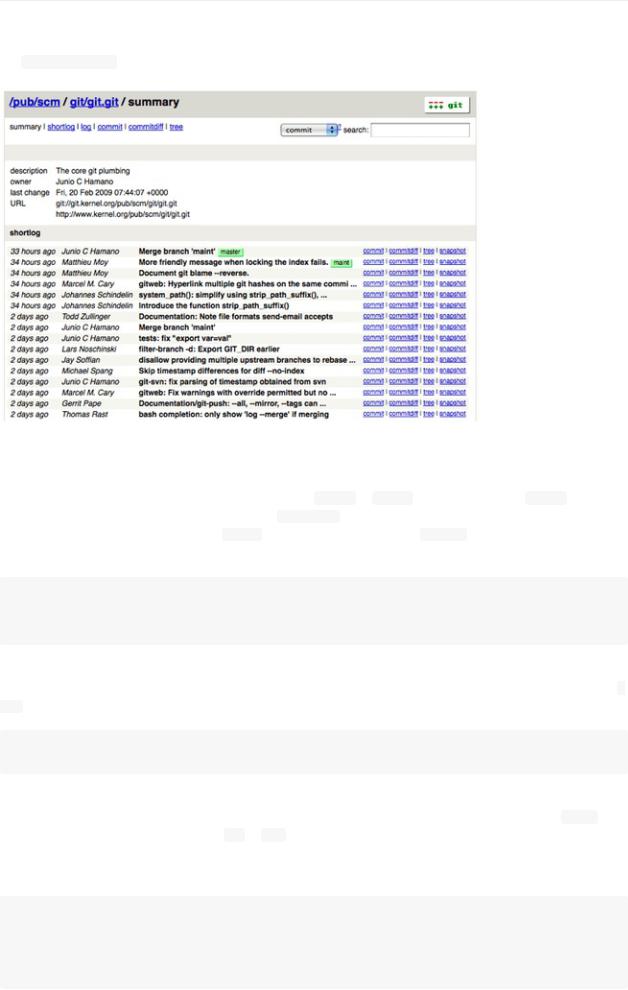
- •Getting Started
- •About Version Control
- •A Short History of Git
- •Git Basics
- •Installing Git
- •First-Time Git Setup
- •Getting Help
- •Summary
- •Git Basics
- •Getting a Git Repository
- •Recording Changes to the Repository
- •Viewing the Commit History
- •Undoing Things
- •Working with Remotes
- •Tagging
- •Tips and Tricks
- •Summary
- •Git Branching
- •What a Branch Is
- •Basic Branching and Merging
- •Branch Management
- •Branching Workflows
- •Remote Branches
- •Rebasing
- •Summary
- •Git on the Server
- •The Protocols
- •Getting Git on a Server
- •Generating Your SSH Public Key
- •Setting Up the Server
- •Public Access
- •GitWeb
- •Gitosis
- •Gitolite
- •Git Daemon
- •Hosted Git
- •Summary
- •Distributed Git
- •Distributed Workflows
- •Contributing to a Project
- •Maintaining a Project
- •Summary
- •Git Tools
- •Revision Selection
- •Interactive Staging
- •Stashing
- •Rewriting History
- •Debugging with Git
- •Submodules
- •Subtree Merging
- •Summary
- •Customizing Git
- •Git Configuration
- •Git Attributes
- •Git Hooks
- •An Example Git-Enforced Policy
- •Summary
- •Git and Other Systems
- •Git and Subversion
- •Migrating to Git
- •Summary
- •Git Internals
- •Plumbing and Porcelain
- •Git Objects
- •Git References
- •Packfiles
- •The Refspec
- •Transfer Protocols
- •Maintenance and Data Recovery
- •Summary

Public Access
What if you want anonymous read access to your project? Perhaps instead of hosting an internal private project, you want to host an open source project. Or maybe you have a bunch of automated build servers or continuous integration servers that change a lot, and you don’t want to have to generate SSH keys all the time — you just want to add simple anonymous read access.
Probably the simplest way for smaller setups is to run a static web server with its document root where your Git repositories are, and then enable that post-update hook we mentioned in the first section of this chapter. Let’s work from the previous example. Say you have your repositories in the /opt/git directory, and an Apache server is running on your machine. Again, you can use any web server for this; but as an example, we’ll demonstrate some basic Apache configurations that should give you an idea of what you might need.
First you need to enable the hook:
$ cd project.git
$ mv hooks/post-update.sample hooks/post-update $ chmod a+x hooks/post-update
What does this post-update hook do? It looks basically like this:
$ cat .git/hooks/post-update #!/bin/sh
#
#An example hook script to prepare a packed repository for use over
#dumb transports.
#
# To enable this hook, rename this file to "post-update".
#
exec git-update-server-info
This means that when you push to the server via SSH, Git will run this command to update the files needed for HTTP fetching.
Next, you need to add a VirtualHost entry to your Apache configuration with the document root as the root directory of your Git projects. Here, we’re assuming that you have wildcard DNS set up to send  to whatever box you’re using to run all this:
to whatever box you’re using to run all this:
<VirtualHost *:80> ServerName git.gitserver DocumentRoot /opt/git <Directory /opt/git/>
Order allow, deny allow from all
</Directory>
</VirtualHost>
You’ll also need to set the Unix user group of the /opt/git directories to www-data so your web server can read-access the repositories, because the Apache instance running the CGI script will (by default) be running as that user:
$ chgrp -R www-data /opt/git
When you restart Apache, you should be able to clone your repositories under that directory by specifying the URL for your project:

$ git clone http://git.gitserver/project.git
This way, you can set up HTTP-based read access to any of your projects for a fair number of users in a few minutes. Another simple option for public unauthenticated access is to start a Git daemon, although that requires you to daemonize the process - we’ll cover this option in the next section, if you prefer that route.

GitWeb
Now that you have basic read/write and read-only access to your project, you may want to set up a simple web-based visualizer. Git comes with a CGI script called GitWeb that is commonly used for this. You can see GitWeb in use at sites
like http://git.kernel.org (see Figure 4-1).
Figure 4-1. The GitWeb web-based user interface.
If you want to check out what GitWeb would look like for your project, Git comes with a command to fire up a temporary instance if you have a lightweight server on your system like lighttpd or webrick . On Linux machines, lighttpd is often installed, so you may be able to get it to run by typing git instaweb in your project directory. If you’re running a Mac, Leopard comes preinstalled with Ruby, so webrick may be your best bet. To start instaweb with a non-lighttpd handler, you can run it with the  option.
option.
$ git instaweb --httpd=webrick [2009-02-21 10:02:21] INFO WEBrick 1.3.1
[2009-02-21 10:02:21] INFO ruby 1.8.6 (2008-03-03) [universal-darwin9.0]
That starts up an HTTPD server on port 1234 and then automatically starts a web browser that opens on that page. It’s pretty easy on your part. When you’re done and want to shut down the server, you can run the same command with the -- stop option:
$ git instaweb --httpd=webrick --stop
If you want to run the web interface on a server all the time for your team or for an open source project you’re hosting, you’ll need to set up the CGI script to be served by your normal web server. Some Linux distributions have a gitweb package that you may be able to install via apt or yum , so you may want to try that first. We’ll walk though installing GitWeb manually very quickly. First, you need to get the Git source code, which GitWeb comes with, and generate the custom CGI script:
$ git clone git://git.kernel.org/pub/scm/git/git.git $ cd git/
$ make GITWEB_PROJECTROOT="/opt/git" \ prefix=/usr gitweb
$ sudo cp -Rf gitweb /var/www/

Notice that you have to tell the command where to find your Git repositories with the GITWEB_PROJECTROOT variable. Now, you need to make Apache use CGI for that script, for which you can add a VirtualHost:
<VirtualHost *:80> ServerName gitserver
DocumentRoot /var/www/gitweb <Directory /var/www/gitweb>
Options ExecCGI +FollowSymLinks +SymLinksIfOwnerMatch AllowOverride All
order allow,deny Allow from all
AddHandler cgi-script cgi DirectoryIndex gitweb.cgi
</Directory>
</VirtualHost>
Again, GitWeb can be served with any CGI capable web server; if you prefer to use something else, it shouldn’t be difficult to set up. At this point, you should be able to visit http://gitserver/ to view your repositories online, and you can use http://git.gitserver to clone and fetch your repositories over HTTP.
